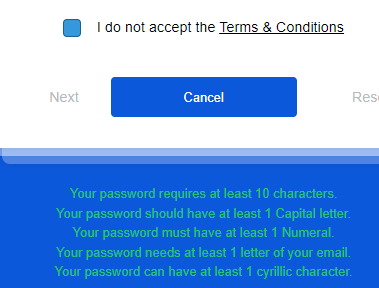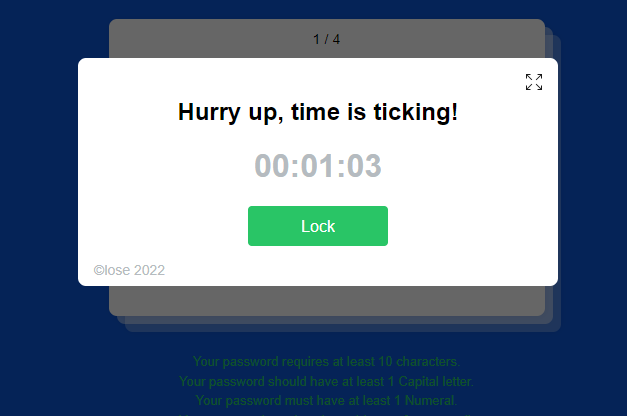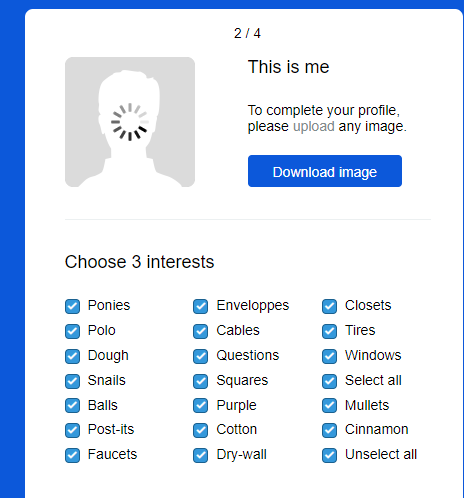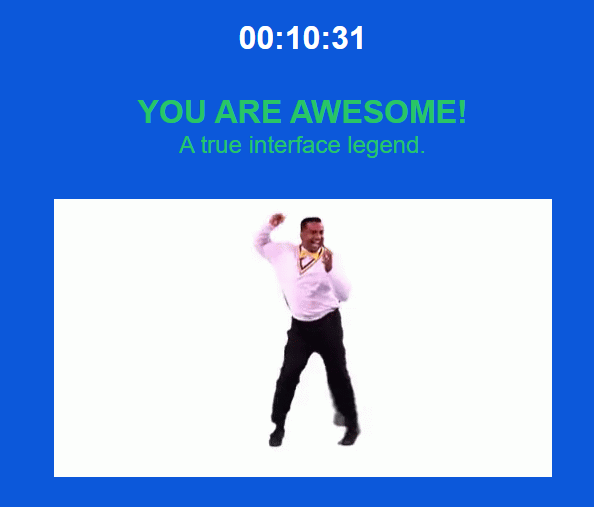Task 10: Attention economy
This week we learned about how the end-goal of a lot of social media companies and businesses is to try to garner our attention and commodify it for profits, manipulation and even mind-control (Harris, 2017)(Tufekci, 2017). The game-play in this week’s task helped to demonstrate how exactly this can be done on a daily basis without people even realizing it as described below.

Upon starting the game, the first screen encountered was a blue screen with tiny print and a huge green button in the centre encouraging me to pay attention to it (through the bright colour and large size) whilst adhering to my natural impulse to ‘push it’ with my mouse. However, as we read this week, advertising on the web can be misleading and can lead to manipulation and control of our time and interests (Tufekci, 2017). Therefore having knowledge of this, I read the small print which was actually encouraging the user NOT to press the big green button to start the game and the even tinier black print at the bottom encouraged me to press there instead to actually start the game. This was a sort of clever play on this advertising tactics often used on us in our daily encounters with using social media and the web. Harris (2017) mentioned that knowing these manipulation tactics used on us can help us to protect our interests and minds.

Another feature of the game was a big red banner at the top saying, “this game uses cookies, is that a problem for you?” with two button next to it saying “yes” or “no” with the “yes” button highlighted in white. This was another clever tactic to highlight how we are often manipulated through websites to press the already highlighted box which is often “yes” in response to the familiar question, “this site uses cookies, would you like to continue?” We do this so automatically in our everyday lives without even reading the fine print that may sign us up to some mailing list or trick us into signing away our personal data in the form of email addresses, location data or gathering data on our interests to then give/sell to businesses (Brignull, n.d.). By allowing these cookies and other tracking mechanisms and data collections to occur, we are giving too much power to the businesses that collect and resell this data to other businesses which can then target us with similar ads and internet stimulus catered to our demographics in order to occupy more of our time and spend more of our money (Harris, 2017). Tufekci (2017) discussed the dangers of giving away our information so easily further citing that in doing so we are also giving up our own power and control of our minds governing what we are interested in and how we spend our time. Another feature similar to this was the “I do not accept the terms and conditions” checkbox which also demonstrates how often the choice to not accept or choose alternate options for our data isn’t given. In allowing these options in an upfront way as some sites are now doing, we can allow for a much more ethical standpoint from which these businesses can operate from perhaps in the future.


Getting back to the game, another feature within the game was a pop-up that kept recurring throughout it saying, “Hurry up, time is ticking!” This pop-up seen above had a big green button in the middle remniscent of the ‘download’ pop-up ads frequently encountered on websites also known as ‘disguised ads’ (Brignull, n.d.). Upon clicking on these ads, you are then redirected to advertising sites rather what your original intention was (in this game’s case it was to close the window rather than lock it) as described by Brignull (n.d.). This particular pop-up had a timer and the terms ‘hurry up’ which was also creating time pressure to distract users from leaving the site and encouraging them to continue to enter their information otherwise facing the consequences of ‘time’s up’ or ‘game over’ which psychologically is tricking users into thinking they will need to start a lengthy process over again or lose what they were aiming to do in the first place, all the while manipulating their time and responses.


This game seemed to use the ‘privacy zuckering’ tactic as well to force me into providing a photo of myself and giving out a lot of personal information such as my age, home address and personal interests/preferences (Brignull, n.d.). It also wouldn’t allow me to proceed further without entering this information which is another manipulation tactic described by Brignull (n.d) as one, “[being] tricked into publicly sharing more information about yourself than you really intended to.” This type of forced wavering of demographic information could again lead to business’ re-selling this data to third parties for targeting subgroups based on the particular demographic they are aiming at or contributing information to build algorithms of my personal preferences, profiling me for targeted ads and preying on my weaknesses (Harris, 2017)(Tufekci, 2017). All of this in turn leads to more time spent on the internet using these sites that have targeted me (Tufekci, 2017) and could potentially lead to personal harm in the future as Brignull (n.d.) describes that giving away this personal information can even sometimes lead to, “being refused services such as insurance or loans”.


Another tactic seemingly highlighted in this game was how advertisers often use ‘misdirection’ to mislead people (Brignull, n.d.). The screenshots above tend to showcase how some businesses use the ‘default’ options to mislead consumers leading people to choose one thing when they are in a rush by highlighting it in a bright, attention grabbing colour as in the example above so they focus on that particular option to choose rather than the dull blue option that blends into the background of the rest of the screen.

Finally, the end of the game presented me with a time or a score and a gif celebrating my completion. The game is therefore rewarding me and inciting instant gratification in doing so. Similar to gambling this tactic almost encourages me to try or play again to achieve a better score next time, for example. The is just another tactic to maintain my attention and waste another 10 minutes of my time on this game and therefore allow myself to relinquish control to the manipulation tactics being used upon me throughout this game.
References
Brignull, H. (n.d.) Types of deceptive design. Deceptive Design. https://www.deceptive.design/types
Harris, T. (2017). How a handful of tech companies control billions of minds every day [Video].
TED Conferences.
https://www.ted.com/talks/tristan_harris_the_manipulative_tricks_tech_companies_use_to_capture_your_at
tention?language=en
Tufekci, Z. (2017). We’re building a dystopia just to make people click on ads [Video]. TED
Conferences.https://www.ted.com/talks/zeynep_tufekci_we_re_building_a_dystopia_just_to_make_people_
click_on_ads?language=en

